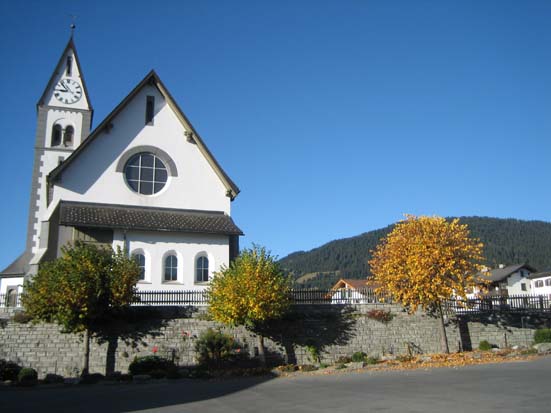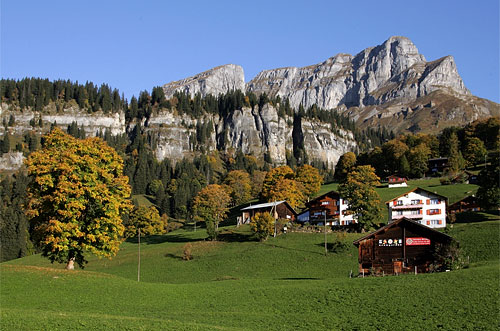|
Laax
Laax (; , ) is a Municipalities of Switzerland, municipality in the Surselva Region in the Switzerland, Swiss Cantons of Switzerland, canton of Graubünden. History Laax is first undoubtedly mentioned 1290–98 as ''Lags''. Laax is first mentioned indirectly in 765 AD when Bishop Tello of Chur granted his share of Flemme (Flims) to the Disentis Monastery, noting Laax in his will. The village appears in a 1290 register of the Cathedral of Chur and was officially independent by 1525 with its own parish church. In 1428, the :de:Freie von Laax bought their freedom from Count[ Rudolf VII of Werdenberg-Sargans, gaining unique autonomy, freedom, and privileges such as market rights and tolls. In 1677, Udalrich de Mont, Bishop of Chur, consecrated the new church in Laax to the patrons Saint Gallus and Saint Otmar. Laax joined the Ilanz district in 1851 after the dissolution of the Laax-Seewis court, and tourism began developing in 1962 with the opening of the Crap Sogn Gion. Geograp ... [...More Info...] [...Related Items...] OR: [Wikipedia] [Google] [Baidu] |
Laaxersee
Laaxersee or Lag Grond is a lake in the village of Laax, Grisons, Switzerland Switzerland, officially the Swiss Confederation, is a landlocked country located in west-central Europe. It is bordered by Italy to the south, France to the west, Germany to the north, and Austria and Liechtenstein to the east. Switzerland .... Its surface area is and maximum depth 5.5 m. Fishing season is from May 1 to September 15. In winter, the lake is generally frozen. External links * * Lakes of Switzerland Lakes of Graubünden LLaaxersee Laax {{graubünden-lake-stub ... [...More Info...] [...Related Items...] OR: [Wikipedia] [Google] [Baidu] |
Vorab
The Vorab is a mountain of the Glarus Alps, located on the border between the cantons of Glarus and Graubünden. The summit (3,028 metres) is also named ''Bündner Vorab'' to distinguish it from a lower summit (3,018 metres) named ''Glarner Vorab''. A glacier runs down its eastern face where the valley continues a moderate inclination down towards Flims, where it can be seen for example from Caumasee. It cannot be seen from the adjacent municipalities on the south though. The northwestern face however consists of a sheer drop towards Elm. Territorially it divides on the municipal areas of Laax on its eastern face, a narrow southern stripe within Siat and Elm on its northwestern face. The secondary peaks that belong to the massive include also the municipalities of Ruschein and Panix. Since 1979 there is a terminal station of a platter lift near the Glarner Vorab. This comes up from the terminal station of a gondola lift ending at the edge of the glacier, all of these installa ... [...More Info...] [...Related Items...] OR: [Wikipedia] [Google] [Baidu] |
Falera
Falera is a Municipalities of Switzerland, municipality in the Surselva Region in the Switzerland, Swiss Cantons of Switzerland, canton of Graubünden. Falera is a part of the ''Alpenarena'' along with the towns of Flims and Laax and is the most secluded of the three. History Falera is a town of rich culture and history. In 1800 B.C., a settlement was started on the Mutta. This came during the Bronze Age and was very significant in the early development of what today is Switzerland. The village is first mentioned in 765 as ''Falariae''. While the first actual mention of a church in Falera was in 840-841. However, the current church was not built until 1491. The church was built on the foot of the Mutta and was named after St. Remigius. Around the church are stone pillars (megaliths or menhirs), arranged geometrically, that are said to date around 1500 B.C. Later, in the year 1903, another church was built. This church was built directly in the village and was named the Herz- ... [...More Info...] [...Related Items...] OR: [Wikipedia] [Google] [Baidu] |
Flims
Flims () is a municipality in the Imboden Region in the Swiss canton of Graubünden. The town of Flims is dominated by the Flimserstein which one can see from almost anywhere in the area. Flims consists of the village of Flims (called Flims Dorf) and the hamlets of Fidaz and Scheia as well as Flims-Waldhaus, the initial birthplace of tourism in Flims, where most of the hotels were built before and after around 1900. Geography Flims has an area of . Of this area, 33.7% is used for agricultural purposes, while 28.9% is forested. Of the rest of the land, 3.6% is settled (buildings or roads) and the remainder (33.9%) is non-productive (rivers, glaciers or mountains). Before 2017, the municipality was located in the Trin sub-district, of the Imboden district, after 2017 it was part of the Imboden Region. Flims is located on a terrace north of the Rhine valley, forming the Ruinaulta gorge here. The country-side has numerous streams and lakes north of the village, from which ... [...More Info...] [...Related Items...] OR: [Wikipedia] [Google] [Baidu] |
Romansh Language
Romansh ( ; sometimes also spelled Romansch and Rumantsch) is a Gallo-Romance languages, Gallo-Romance and/or Rhaeto-Romance languages, Rhaeto-Romance language spoken predominantly in the Switzerland, Swiss Cantons of Switzerland, canton of the Grisons (Graubünden). Romansh has been recognized as a national Languages of Switzerland, language of Switzerland since 1938, and as an official language in correspondence with Romansh-speaking citizens since 1996, along with Swiss Standard German, German, Swiss French, French, and Swiss Italian, Italian. It also has Official language, official status in the canton of the Grisons alongside German and Italian and is used as the medium of instruction in schools in Romansh-speaking areas. It is sometimes grouped by linguists with Ladin language, Ladin and Friulian language, Friulian as the Rhaeto-Romance languages, though this is disputed. Romansh is one of the descendant languages of the Vulgar Latin, spoken Latin language of the Roman Empi ... [...More Info...] [...Related Items...] OR: [Wikipedia] [Google] [Baidu] |
Glarus Süd
Glarus Süd is a municipality in the Switzerland, Swiss canton of Glarus. It comprises the upper Linth valley, and the entire Sernf valley, and includes the villages of Betschwanden, Braunwald, Glarus, Braunwald, Diesbach, Glarus, Diesbach, Elm, Switzerland, Elm, Engi, Switzerland, Engi, Haslen, Glarus, Haslen, Hätzingen, Leuggelbach, Linthal, Glarus, Linthal, Luchsingen, Matt, Switzerland, Matt, Mitlödi, Nidfurn, Rüti, Glarus, Rüti, Schwanden, Glarus, Schwanden, Schwändi, near Schwanden, Glarus, Schwändi and Sool, Glarus, Sool. Glarus Süd is one of three municipalities of the canton of Glarus, the others being Glarus and Glarus Nord. History The municipality of Glarus Süd was created on 1 January 2011, incorporating the former municipalities of Betschwanden, Braunwald, Glarus, Braunwald, Elm, Glarus, Elm, Engi, Glarus, Engi, Haslen, Glarus, Haslen, Linthal, Glarus, Linthal, Luchsingen, Matt, Glarus, Matt, Mitlödi, Rüti, Glarus, Rüti, Schwanden, Glarus, Schwanden, Sc ... [...More Info...] [...Related Items...] OR: [Wikipedia] [Google] [Baidu] |
Surselva Region
Surselva Region is one of the eleven administrative districts in the canton of Graubünden in Switzerland. It was created on 1 January 2017 as part of a reorganization of the canton.Swiss Federal Statistical Office – Amtliches Gemeindeverzeichnis der Schweiz – Mutationsmeldungen 2016 accessed 16 February 2017 Surselva Region has an area of , with a population of as of .. Its area corresponds exactly to that of its predecessor, Surselva District, but all of its former subdistricts (''Kreise'') – Disentis, Ilanz, Lumnezia/Lugnez, Ruis and Safien – have politically ceased to exist. ''Surselva'' (literall ... [...More Info...] [...Related Items...] OR: [Wikipedia] [Google] [Baidu] |
Ruschein
Ruschein (, ) is a former municipality in the district of Surselva in the canton of Graubünden in Switzerland. Its official language is the Sursilvan dialect of Romansh. On 1 January 2014 the former municipalities of Ruschein, Castrisch, Ilanz, Ladir, Luven, Pitasch, Riein, Schnaus, Sevgein, Duvin, Pigniu, Rueun and Siat merged into the new municipality of Ilanz/Glion.Nomenklaturen – Amtliches Gemeindeverzeichnis der Schweiz accessed 13 December 2014 History Ruschein is first mentioned in 765 as ''Rucene''.Geography [...More Info...] [...Related Items...] OR: [Wikipedia] [Google] [Baidu] |
Sagogn
Sagogn (; ) is a Municipalities of Switzerland, municipality in the Surselva Region in the Cantons of Switzerland, canton of Graubünden in Switzerland. History Sagogn is first mentioned in 765 as ''Secanio''. Geography Sagogn has an area, , of . Of this area, 23.2% is used for agricultural purposes, while 59.7% is forested. Of the rest of the land, 4.7% is settled (buildings or roads) and the remainder (12.4%) is non-productive (rivers, glaciers or mountains). Before 2017, the municipality was located in the Ilanz sub-district of the Surselva district, after 2017 it was part of the Surselva Region. It is on the northern slope above the Vorderrhein on the bank of the Gruob (or Foppa). It consists of the village sections of Innerdorf (Vitg Dadens) and Ausserdorf (Vitg Dado). Until 1943 Sagogn was known by its German name as Sagens. [...More Info...] [...Related Items...] OR: [Wikipedia] [Google] [Baidu] |
2011 Swiss Federal Election
Federal elections were held in Switzerland on 23 October 2011. All of the Federal Assembly were to be elected: all 200 seats in the National Council and all 46 seats in the Council of States. Voter turnout was 49.1%, compared to 48.9% in 2007. National Council At the last election, in 2007, the Swiss People's Party (SVP) won the highest share of the vote ever recorded for a single party in Switzerland, with 29% of the vote. Soon after, a moderate faction split from the SVP, forming the Conservative Democratic Party (BDP). In the 2011 election, the two neophyte parties BDP and Green Liberal Party (GLP) were successful, each receiving 5.4% of the popular vote. Both the GLP and the BDP have gained the required five seats to form their own parliamentary groups, suggesting a split of the centrist CVP/EVP/glp group. All other major parties lost votes, the Swiss People's Party (SVP) for the first time since the 1987 elections. With 26.6% of the popular vote, the SVP is st ... [...More Info...] [...Related Items...] OR: [Wikipedia] [Google] [Baidu] |
Saint Otmar
Othmar, (also ''Audomar'', 689 – 759) was a Medieval monk and priest. He served as the first abbot of the Abbey of St. Gall, a Benedictine monastery near where the city of St. Gallen, now in Switzerland, developed. Life Othmar was of Alemannic descent, received his education at the cathedral school in Chur in Rhaetia. He was ordained priest, and for a time presided over a church of St. Florinus in Rhaetia. This church was probably identical with the one of St. Peter at Remus, where Florinus had laboured as a priest and was buried.Ott, Michael. "St. Othmar." The Catholic Encyclopedia Vol. 11. New York: Robert Appleton Company, 1911. 24 November 2021 In 720 Waltram of Thurgau appointed Othmar superior over the cell of [...More Info...] [...Related Items...] OR: [Wikipedia] [Google] [Baidu] |







